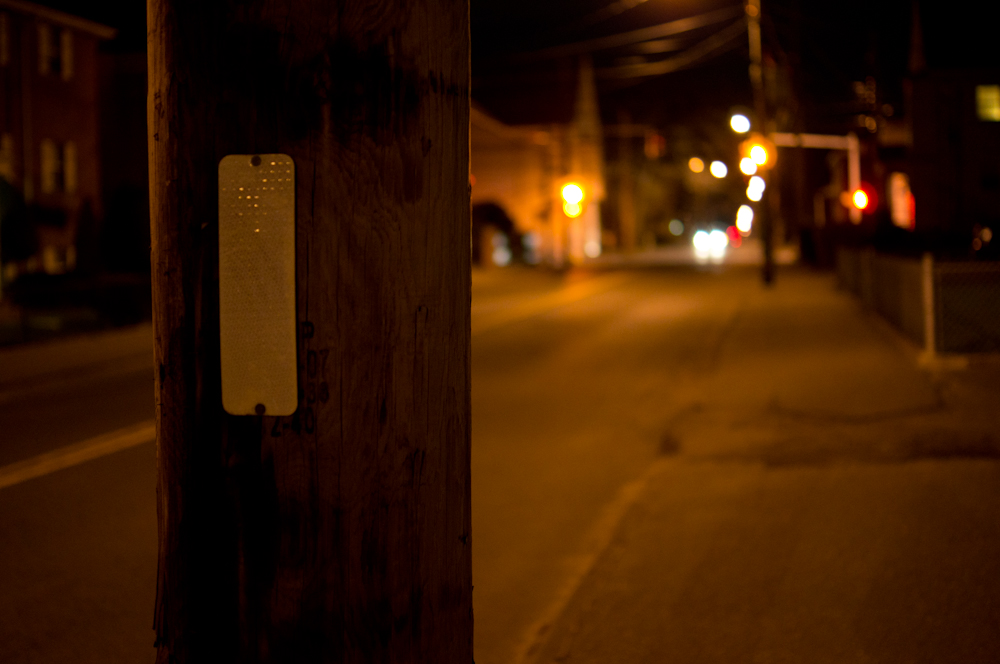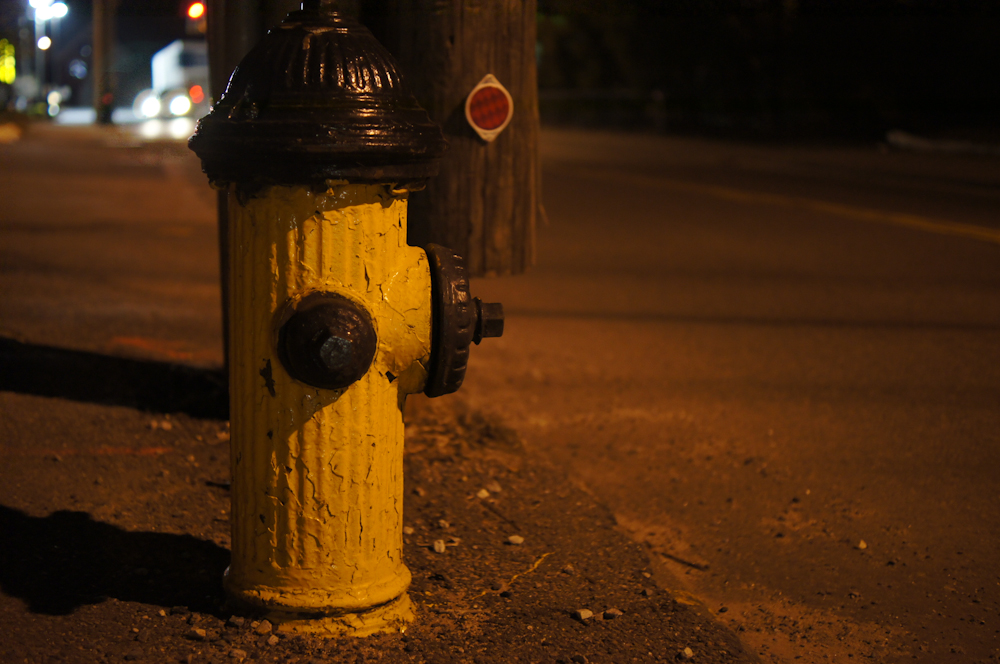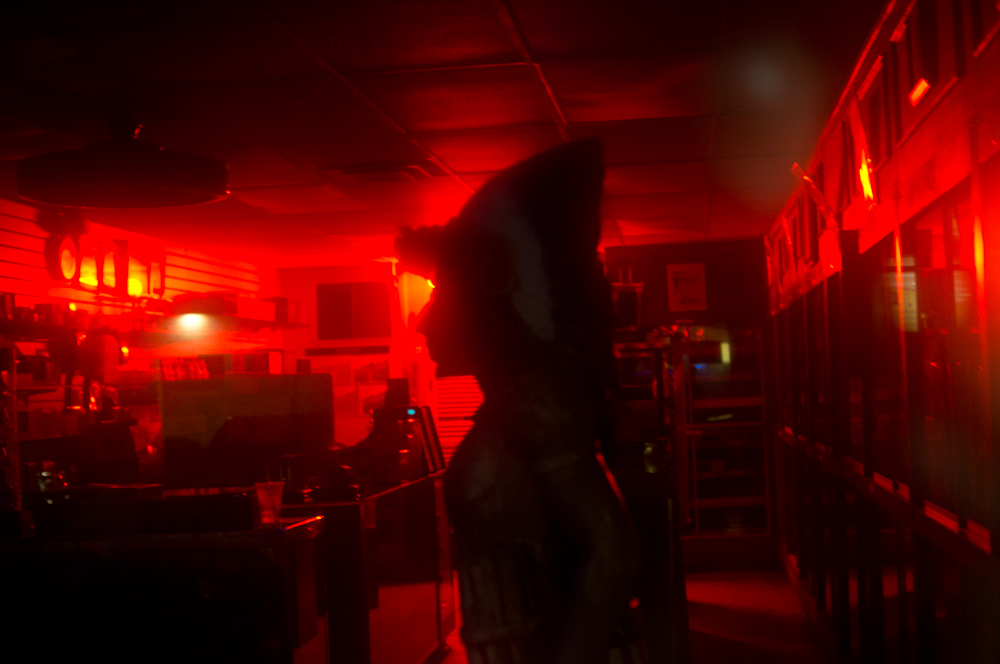Using the A55 at night was probably the most fun I’ve had with the camera. The large, bright external screen was easily visible in low light which made framing a snap. Also, it allowed for a much more stable shooting position. I could pull my elbows into my body and hold the camera low to create a very solid and stable shooting platform. This shooting stance, along with the in body stabilization, allowed me to get clean images with shutter speeds as low as 1/5 of a second. Click through to see how the A55 manged in the dark.
Equipment Used
- Sony A55 with 18-55mm F/2.5-5.6
- Sony 35mm F/1.8 SAM
- Crumpler 7 Million Dollar Home
- Click Elite Wrist Strap
As I mentioned in Day 2, the A55 has a pretty slick mode called hand-held low light mode. This mode works by taking six images in rapid succession. It then stacks the images together to create one clean image. I tried this a few times and while it worked well, I never really felt the need to use this feature. With relatively fast 35mm F/1.8 SAM lens, in-body image stabilization and good high ISO performance, the A55 is a great low light shooter.
The one area where the A55 struggled when shooting at night was focusing. Honestly, based on my shooting experience with the A55 in the prior days, I wasn’t surprised that the A55 was going to have some trouble with AF at night. The AF had a hard time locking on to anything, even stationary objects with good contrast. It usually took 3-4 times for me to finally get a lock. I actually ended up using manual focus to get a few shots as I couldn’t get the AF to lock on. Again, lots of cameras have trouble focusing in low light or at night so I wouldn’t call the A55’s lack of ability to focus in low light unique to this camera.
The above image shows just how good the metering system is with the A55. The overhead lights were actually very bright while the area behind her was pretty dark. I tried using manual focus for this shot…it looks like I may have missed a bit. I would say this is still a keeper but it’s not as sharp as it could have been if I had nailed the focus.
This shot was a little trickier. I was shooting into a store through a very dirty glass window…probably from all the cigar smoke. I noticed the cigar store Indian (Native American…I never know what is PC) and I had to get a shot. Any Seinfeld fans out there? You know what episode I’m talking about.
ISO Performance
While image noise can technically measured with complex tests, I think each person has to determine what is acceptable to them. Some people zoom into each image to see if they can detect the slightest hint of noise. Others could care less and only clean up noise when it overwhelms the image. I would put myself in the middle of these two groups. I don’t particularity like noise, but I don’t zoom into every image to see if I can see the slightest hint of noise. The below are my thoughts on the A55‘s ISO performance, yours may differ from mine.
So, how did the A55 handle image noise? I was actually pretty impressed with the A55’s ISO performance. Noise is well controlled in RAW images and even at the highest ISO setting of 12800, the amount of noise is definitely noticeable but manageable. The noise is very fine and cleans up quite easily in Lightroom. I didn’t put up the ISO 100 & 200 for the JPEGs as they looked identical to the RAW images.
JPEGs
As you can see from the above chart, around ISO 3200 you start to see a loss of detail and colors look smudged. Not surprisingly, as you get into the higher ISOs ( 6400 & 12800) colors start to look washed out and there is a further loss of detail and contrast. Like I’ve said in previous posts, the JPEG performance from the A55 is actually quite good. A color shift is noticeable when compared to the RAW files but I’m happy with the results straight from the camera. With that being said, I’m a big fan of shooting RAW and I think that is the way to go when shooting with the A55, even when shooting at higher ISOs.
RAW
When viewing images at a normal size, noise starts to become noticeable around ISO 1600 but it’s nothing to be concerned about. I probably wouldn’t make any post processing noise adjustments until ISO 6400 unless I was blowing up the image to a larger size. I think this is impressive ISO performance from a consumer DSLR. Shooting in RAW may result in more noise but you also have the greatest amount of flexibility to clean up the image in post processing.
Observations
Even with it’s finicky AF, the A55 was still a pleasure to shoot at night and in low light. I’d make sure you grab the 35mm F/1.8 if you’re going to need to shoot in low light as the kit lens just isn’t going to cut it. Noise is well controlled in RAW images and even shots taken at high ISOs are easy to clean up in post processing. For all of you JPEG shooters, ISO performance is good but images will start to get mucked up around ISO 3200 even with the noise reduction set to its lowest setting. I’d shoot RAW + JPEG if you ever find yourself in tough conditions. This will give you the flexibility of the RAW file with the JPEG if you just need a quick image.
Please Support The Phoblographer
We love to bring you guys the latest and greatest news and gear related stuff. However, we can’t keep doing that unless we have your continued support. If you would like to purchase any of the items mentioned, please do so by clicking our links first and then purchasing the items as we then get a small portion of the sale to help run the website.






